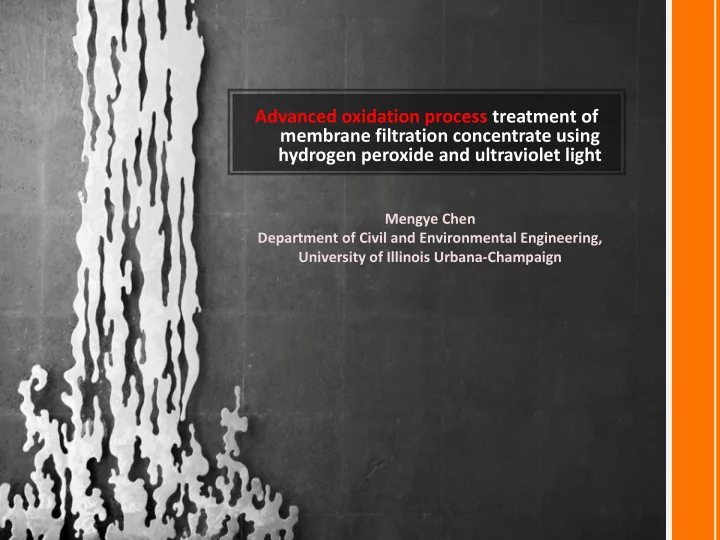

Advanced oxidation process treatment of membrane filtration concentrate using hydrogen peroxide and ultraviolet light Mengye Chen Department of Civil and Environmental Engineering, University of Illinois Urbana-Champaign
GE Osmonics HL Aerobic Effluent Anaerobic Downflow Internal Concentrate Chamber Hanging Circulation Sponge CH 4 + CO 2 Reactor AOP Waste Sludge Organic Carbon Influent Project overview Membrane biological reactor, synthetic wastewater with ≈ 3300ppm of COD MFC: SMP, dead cells, biofilm, low biodegradability, high organic concentration
Introducing ADVANCED OXIDATION PROCESS
Chemistry • One of the strongest oxidants in nature Non-selectively reacts with organic (Zeta potential: +2.33V) molecules • Break up cell membrane • Remove COD, TOC, color and odor
Batch experiment WWTP secondary effluent Filtration concentrate Table 1- Composition of NFC Parameters Unit Concentration TSS mg/L 8.8 ± 0.96 VSS mg/L 5.1 ± 0.68 COD mg/L 46.0 ± 8.21 TOC mg/L 16.0 ± 4.03 Ca mg/L 40.1 ± 4.3 Mg mg/L 31.9 ± 0.7 K mg/L 572.2 ± 29.9 Na mg/L 329.3 ± 5.4 pH - 8.8 ± 0.098 Table 2-Composition of Urbana WWTP secondary effluent Parameters Unit Concentration COD mg/L 24 ± 0.075 TOC mg/L 7.2 ± 0.082 pH - 8.2 ± 0.06
Results and COD/TOC ratio change • Higher H 2 O 2 dosage gave higher removal • Complete COD removal appeared in treating secondary effluent but not TOC (dosage of 600 ppm H 2 O 2 at 2 hours, COD removal was 100% and TOC removal was 29%) • The preliminary optimal dosage for AOP treating NFC is [H 2 O 2 ] = 1000 mg/L or [H 2 O 2 ]/ [COD] =18.35 and the UV intensity is 9.07 kWh/m 3 , with COD and TOC removal of 63.89% and 38.54% respectively in 5 hours. • COD and TOC were not removed at the same rate Resistance to dichromate oxidation increased
AOP running in sequential batch mode Removal efficiency without UV malfunction 5 hours: COD- 53.04%±8.85% TOC- 35.48%±3.53% 24 hours: COD- 82.98%±7.94% TOC- 63.09%±5.19% Removal efficiency 5 hours: COD- 45.92%±14.32% TOC- 32.67%±5.54% 24 hours: COD- 77%±10.9% TOC- 59.36%±7.9%
Post treatment- Biofilm reactor • Average TOC removal: 30.63%±9.13% • COD/TOC ratio increased and COD concentration increased • Overall TOC removal: 78.65%
Recent works- AOP CSTR Average removal efficiency: COD- 76.46%±7.29%, TOC- 65.79%±5.27%
Recent works-HPLC analysis
Recent works-Post treatment Malfunction of MnO2 reactor Shock response Average TOC removal: 35.88%±9.93%
Questions?
Recommend
More recommend